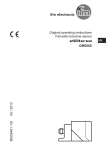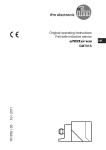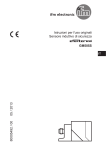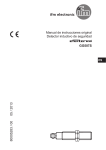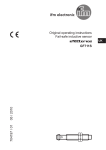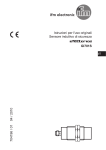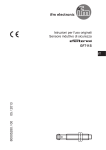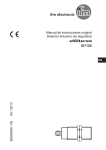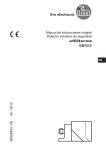Download Original operating instructions Fail-safe inductive sensor
Transcript
Original operating instructions
Fail-safe inductive sensor
UK
701833 / 03
06 / 2010
GG505S
Contents
1 Preliminary note ���������������������������������������������������������������������������������������������������3
1�1 Explanation of symbols ����������������������������������������������������������������������������������3
2 Safety instructions �����������������������������������������������������������������������������������������������4
2�1 Safety-related requirements regarding the application ����������������������������������4
3 Items supplied������������������������������������������������������������������������������������������������������5
4 Functions and features ����������������������������������������������������������������������������������������5
5 Function ���������������������������������������������������������������������������������������������������������������6
5�1 Enable zone ���������������������������������������������������������������������������������������������������6
5�2 Protection against simple defeating ���������������������������������������������������������������7
6 Installation������������������������������������������������������������������������������������������������������������7
7 Electrical connection ��������������������������������������������������������������������������������������������8
8 Set-up ������������������������������������������������������������������������������������������������������������������9
8�1 Activate adjustment mode �����������������������������������������������������������������������������9
8�2 Determine the enable zone ���������������������������������������������������������������������������9
8�3 End adjustment mode ����������������������������������������������������������������������������������10
9 Operation �����������������������������������������������������������������������������������������������������������10
9�1 Sensor signals ���������������������������������������������������������������������������������������������10
9�2 Input characteristics / output characteristics ������������������������������������������������ 11
9�3 Cross faults ������������������������������������������������������������������������������������������������� 11
9�4 Operating mode �������������������������������������������������������������������������������������������12
9�4�1 Delayed switching of the LED�������������������������������������������������������������12
9�4�2 Switching of the LED without delay ����������������������������������������������������13
9�5 Response times �������������������������������������������������������������������������������������������14
9�6 LED display �������������������������������������������������������������������������������������������������15
10 Scale drawing ��������������������������������������������������������������������������������������������������16
11 Technical data ��������������������������������������������������������������������������������������������������16
12 Troubleshooting �����������������������������������������������������������������������������������������������19
13 Maintenance, repair and disposal ��������������������������������������������������������������������19
14 Approvals / standards ��������������������������������������������������������������������������������������19
15 Terms and abbreviations����������������������������������������������������������������������������������20
2
1 Preliminary note
The instructions are part of the unit� They are intended for authorised persons
according to the EMC and Low Voltage Directive and safety regulations�
The instructions contain information about the correct handling of the product�
Read the instructions before use to familiarise yourself with operating conditions,
installation and operation�
Adhere to the safety instructions�
1.1 Explanation of symbols
UK
► Request for action
LED on
LED off
LED flashes
LED flashes quickly
Important note
3
2 Safety instructions
• Follow the operating instructions�
• Improper use may result in malfunctions of the unit� This can lead to personal
injury and/or damage to property during operation of the machine� For this
reason note all remarks on installation and handling given in these instructions�
Also adhere to the safety instructions for the operation of the whole installation�
• In case of non-observance of notes or standards, specially when tampering
with and/or modifying the unit, any liability and warranty is excluded�
• The unit must be installed, connected and put into operation by a qualified
electrician trained in safety technology�
• The applicable technical standards for the corresponding application must be
complied with�
• For installation the requirements according to EN 60204 must be observed�
• In case of malfunction of the unit please contact the manufacturer� Tampering
with the unit is not allowed�
• Disconnect the unit externally before handling it� Also disconnect any
independently supplied relay load circuits�
• After setup the system has to be subjected to a complete function check�
• Onlyusetheunitunderthespecifiedoperatingconditions(→11Technical
data)� In case of special operating conditions please contact the manufacturer�
• Useonlyasdescribedbelow(→4).
2.1 Safety-related requirements regarding the application
It must be ensured that the safety requirements of the respective application
correspond to the requirements stated in these instructions�
Observe the following requirements:
► Take measures to avoid metallic objects being placed on the sensing face
intentionally or unintentionally�
► Adhere to EN 1088 for interlocking devices associated with guards�
► Adheretothespecifiedoperatingconditions(→11Technicaldata).Useof
the sensor in the vicinity of chemical and biological media as well as ionising
radiation is not permitted�
4
► Adhere to the principle of normally closed operation for all external safety
circuits connected to the system�
► In case of faults within the fail-safe sensor which result in the defined safe
state: take measures to maintain the safe state when the complete control
system continues to be operated�
► Replace damaged units�
3 Items supplied
1 fail-safe sensor GG505S with 2 M18 mounting nuts,
UK
1 operating instructions GG505S, ident no� 701833�
If one of the above-mentioned components is missing or damaged, please contact
one of the ifm branch offices�
4 Functions and features
The fail-safe inductive sensor detects metal without contact�
Safety function SF: the safe state (output stage switched off; logic "0") is achieved
when undamping greater than or equal to the safe switch-off distance sar
(→11Technicaldata).
Alsoobservethenotesoninstallationofthesensor(→6Installation).
The fail-safe sensor conforms to the category 4 according to EN 954-1 (valid until
31 December 2011), Performance Level e according to EN ISO 13849-1:2008 as
well as to the requirements SIL 3 to IEC 61508�
The unit corresponds to the classification I2A18SP2M to IEC 60947-5-2 for nonflushinstallation(→6Installation).
The fail-safe inductive sensor has been certified by TÜVNord�
5
5 Function
mm
Dual LED: signal (yellow); power (green)
Fail-safe sensor
Close range
Enable zone
Safe switch-off distance sar
Target
5.1 Enable zone
The output is only enabled when damped in the enable zone� Outside this enable
zone the output remains switched off�
If damped with a standard target plate of 24 x 24 x 1 mm made of FE360 (= mild
steel) and non-flush installation to IEC 60947-5-2 the enable zone is in the range
of 3���6 mm�
The safe switch-off distance sar is > 15 mm�
The enable zone is different if damping elements which deviate from the standard
target plate in terms of material, form and size are used�
Enable zone for other materials*:
Material
steel FE360
stainless steel 1�4301/304S15
AIMg3G22
CuZn37
Enable zone
3���6 mm
1�7���4�3 mm
0�5���2�2 mm
0�5���2�5 mm
* Typical values for damping with a reference target of 24 x 24 x 1 mm and non-flush
installation to IEC 60947-5-2 at an ambient temperature of 20°C�
6
5.2 Protection against simple defeating
The fail-safe sensor reacts to metal objects, e�g� the frame of a security door�
Other metal objects that are not intended to enable the sensor must not be
allowed to enable the fail-safe sensor, either intentionally or unintentionally�
► Take measures to prevent metal objects, except the designated target,
from being placed on the sensing face or in the enable zone intentionally
or unintentionally�
In addition, the sensor has the following switching characteristics to make simple
defeating of its safety function more difficult:
UK
1� By slowly introducing a metallic object into the enable zone, the output is
immediately switched, but displayed by the signal LED with a delay of about 3
s(→9.4.1DelayedswitchingoftheLED).Bydoingso,theobjectisgenerally
in the close range before the LED indication is lit� The technical instructions
concerning the restart of the installation must be observed�
2� If the object stays in the close range for longer than approx� 2 s, the output is
completely disabled and no longer enabled if damped in the enable zone� If
the object stays in the close range for longer than approx� 5 s, the adjustment
modeisactivated(→8.1Activateadjustmentmode).
Release of the enable zone can be carried out
•either by undamping (> 15 mm) for a time of more than 2 s
•or by a voltage interruption
(→8.3Endadjustmentmode).
6 Installation
The unit is non-flush mountable according to IEC 60947-5-2, type I2A18SP2M�
► Ensure the unit cannot work loose� Maximum tightening torque: 40 Nm
► Adhere to the installation conditions in accordance with the figures 1 to 3:
1
2
3
7
► Install the unit non-flush only�
In case of flush installation, the sensing range is increased and the sensor
can remain permanently switched (not allowed)�
7 Electrical connection
Wiringdiagram→11Technicaldata
► Disconnect the unit� Also disconnect any independently supplied relay load
circuits�
► Supply voltage: connect L+ to pin 1 and L- to pin 3 of the connector�
The nominal voltage is 24 V DC� This voltage may vary between 19�2 V and
30 V incl� 5% residual ripple to EN 61131-2�
In case of one fault the supply voltage must not exceed 60 V DC for more
8
than 0�2 s up to a max� value of 120 V DC (this corresponds to SELV to
EN 60950-1)�
For unit with cULus approval and the scope of validity cULus:
The device shall be supplied from an isolating transformer having a
secondary listed fuse rated either
a) max� 5 amps for voltages 0~20 Vrms (0~28�3 Vp) or
b) 100/Vp for voltages of 20~30 Vrms (28�3~42�4 Vp)�
8 Set-up
8.1 Activate adjustment mode
For easy and reliable installation the sensor can be put in the adjustment mode�
This is done by placing a metallic
object directly in front of the sensing
face of the fail-safe sensor (close
range)�
After approx� 5 s the yellow signal
0
15
mm
LED starts to flash: the adjustment UK
>5s
mode is active�
Signal
As long as this mode is active, the
Power
output stage remains in the safe
state ("0")�
Close
range
Enable zone
8.2 Determine the enable zone
If the sensor is in the adjustment mode, the enable zone of the sensor can be
determined by moving the damping element�
As soon as damping is carried out
in the enable zone, the yellow LED
goes out�
If the target is in the close range or in
the immediate vicinity of the enable
0
15
mm
zone, the LED starts to flash again�
Signal
Signal
Signal
Power
Power
Power
Close range
Enable zone
9
8.3 End adjustment mode
0
15
mm
If the sensor is undamped for more
than 2 s (> 15 mm), the adjustment
mode is switched off and the yellow
LED goes out�
This can also be achieved by power
off�
<2s
Signal
Power
>2s
Signal
Power
Close range
Enable zone
9 Operation
9.1 Sensor signals
The safe state is when the output is switched off (zero-current state: logic "0")� The
fail-safe sensor must be operated with a clock signal on its clock input (TE)� The
clock input signal must meet the defined time conditions (see figure)�
T
T1
1
0
1
0
td
Clock input (TE)
Output
10
T2
T1≥50ms
T2≥50ms
T = 100���500 ms
td = 1�0���1�5 ms (± 10 %)
9.2 Input characteristics / output characteristics
The electrical input characteristics are compatible with the output characteristics to
EN 61131-2 (nominal current 0�1 A and nominal voltage 24 V):
Logic "1"
Logic "0"
Permissible test pulse duration
≥11V,<30V
≤5V
≤1.0ms
Input current approx� 3 mA
Leakage current 500 µA
If the target is in the enable zone and there is no sensor fault, the clock input
signal is transferred to the output with the delay td� The output characteristics are
UK
compatible with the input characteristics to EN 61131-2 type 1 or 2:
Logic "1"
≥15V
≥11V
Logic "0"
≤5V
2���15 mA
15���30 mA
Outputimpedancetyp.27Ω
Leakage current 0 mA
(pull-down current typ� 30 mA)
If the target is outside the enable zone, the output is switched off (logic "0")�
Non-observance of the time diagram (e�g� no time offset td; permanently
logic"1"→9.1)isafault.
9.3 Cross faults
Cross faults are detected by the fail-safe sensor and lead to an error
message (permanently logic "1")� The pull-down current of the clock
generator must not exceed 30 mA as the fail-safe sensor can no longer
switch this current� An error message is no longer possible then�
11
9.4 Operating mode
The length of the preceding undamping determines whether the yellow LED
comesonwithadelay(→9.4.1)orwithoutdelay(→9.4.2)whenatargetmoves
into the enable zone� In any case, the output switches on without delay�
In case of undamping the output switches off and the yellow LED goes out without
delay�
In case of damping in the close range the output switches off immediately whereas
the yellow LED goes out with a delay of approx� 2 s� With the deactivation of the
LED the output is maintained in the safe state (logic "0")� Thus, switching on again
in the enable zone is not possible� Enabling is done by undamping (> 15 mm)
ofmorethan2sorbyinterruptingthevoltage(→5.2Protectionagainstsimple
defeating)�
9.4.1 Delayed switching of the LED
Undamping > 2s:
0
>3s
Signal
Power
Close range
Enable zone
12
15
mm
If the target was away from the
sensor for more than approx� 2 s
(> 15 mm), the yellow LED goes on
with a delay of approx� 3 s in case of
damping in the enable zone�
This is also the case if the target is in
the enable zone when the voltage is
switched on�
9.4.2 Switching of the LED without delay
If the target was away from the
sensor for less than 2 s (> 15 mm),
the yellow LED comes on without
delay in case of damping in the
enable zone�
Undamping<2s:
0
≈ 0 s*)
15
mm
UK
Signal
Power
Close range
Enable zone
*)
except for the first start-up
13
9.5 Response times
(Without response time of the monitoring unit)
Response time on safety request (removal from the enable zone)
≤ 20 ms 1)
Response time when approaching the close range (non safetyrelated zone)
≤T
Response time when approaching the enable zone (enable time):
Response time when switching off the clock input
Response time for enabling to rising edge of TE (damped in the
enable zone)
Response time / risk time for safety-related faults
1)
2)
typ� 100 ms
≤ 200 ms 2)
≤ 2 ms
typ� 40 ms
max� 100 ms
≤T
Permissible dwell time in the close range
approx� 2 s
Timedelayforactivationoftheadjustmentmode(→8.1Activate
adjustment mode)
approx� 5 s
Dwelltimeintheundampedcondition(≥15mm)toreturnintothe
operatingmode(→8.3Endadjustmentmode)
approx� 2 s
During this time the output is switched off (logic "0")�
As from this instant the clock input signal is transferred to the output with a delay�
14
9.6 LED display
LED
Signal
Power
Operating status
No voltage supply
Signal
Power
Undervoltage
Signal
Power
Overvoltage
Signal
Power
Signal
Power
Output switched off (safe state), target outside the
enable zone (operating mode)
or
target in the enable zone (adjustment mode)
Output switched, target in the enable zone
(operating mode)
Signal
Power
Output switched off (safe state), target outside the
enable zone (adjustment mode)
Signal
Power
Internalorexternalfault(→12Troubleshooting)
Sensor signals
UK
15
10 Scale drawing
Dual LED: signal (yellow); power (green)
11 Technical data
GG505S
GIGA-4015-US
Fail-safe inductive sensor
Metal thread M18 x 1
M12 connector
Enable zone: 3���6 mm
non-flush mountable
Conforms to the requirements of:
SIL 3 to IEC 61508: 2000, EN ISO 13849-1: 2008 category 4 PL e
Operating voltage
Short-circuit protection
Reverse polarity protection
Current consumption
Response time
16
24 V DC (19�2���30 V)
yes
yes
<15mA
Response time on safety request (removal
fromtheenablezone):≤20ms
Response time when approaching the
enablezone(enabletime),typ.100ms,≤
200 ms
Power-on delay time
Safe switch-off distance sar
Operating mode
EMC / vibration, shock
Application
5s
15 mm
continuous operation (maintenance-free)
according to IEC 60947-5-2
Class C to EN 60654-1
(weatherproof application)
Climate
Ambient temperature -25���70 °C*)
10���40 °C **)
UK
Relative air humidity 5���95 % *)
5���70 % **)
Rate of temperature change 0�5 K/min
Air pressure 80���106 kPa
Mission time TM (mission time)
max� 87 600 h (10 years) *)
max� 175 200 h (20 years) **)
Safety-related reliability PFH (PFHD)
MTTFD
DC / CCF / Cat�
Protection
Housing materials
Display
Connection
1�1 x 10-9/h
> 2 500 years
99 % / 65 % / 4
IP 68 / IP 69K (to EN 60529), III
PBT, high-grade stainless steel
LED yellow (signal); LED green (power)
M12 connector, gold-plated contacts
17
Wiring diagram
safety relay or PLC to EN 61131-2
Core colours:
BK: black
BN: brown
BU: blue
WH: white
The core colours (BN, BK, BU, WH) apply to the use of ifm sockets�
Comments:
*) Mission time TM= 10 years
**) Mission time TM = 20 years
•Unless stated otherwise, all data refer to the 24 x 24 x 1 mm reference target plate to
IEC 60947-5-2 (FE360 = mild steel) over the whole temperature range�
18
12 Troubleshooting
LEDdisplay→9.6
Problem
Possible cause
Troubleshooting
No LED display
No voltage supply
Apply voltage
Power LED flashes and
sensor does not switch
•Undervoltage
•Overvoltage
Correctthevoltage(→11Technical
data)
The Power LED is off
and the signal LED
flashes
Internal or external fault
•Undamp / damp
•Power off / on
•Replace the unit
•Check wiring / connections
•Check external electronics (e�g�
G150xS or PLC)
UK
13 Maintenance, repair and disposal
If used correctly no maintenance and repair measures are necessary�
Only the manufacturer is allowed to repair the unit�
After use dispose of the unit in an environmentally friendly way in accordance with
the applicable national regulations�
14 Approvals / standards
The following standards and directives have been applied:
• 2006/42/EC European Machinery Directive
• 2004/108/EC EMC Directive
• DIN EN 954-1 (1996) category 4, safety of machinery, safety-related parts of
control systems (valid until 31 December 2011)
• EN ISO 13849-1: 2008 PL e, safety of machinery, safety-related parts of control
systems
• IEC 60947-5-2 (2008) low-voltage switchgear: control circuit devices and
switching elements - proximity switches
• IEC 61508 (2000)
• UL 508
19
15 Terms and abbreviations
Cat�
Category
CCF
Common Cause Failure
DC
Diagnostic Coverage
MTTFD
Mean Time To Dangerous
Failure
PFH
(PFHD)
Probability of (dangerous)
Failure per Hour
PL
Performance Level
PL to EN ISO 13849-1
SIL
Safety Integrity Level
SIL 1-4 to IEC 61508
PLC
TM
20
Classification of the safety-related
parts of a controller as regards their
resistance to failures�
Programmable Logic Controller
Mission Time
= maximum service life
UK
21






















